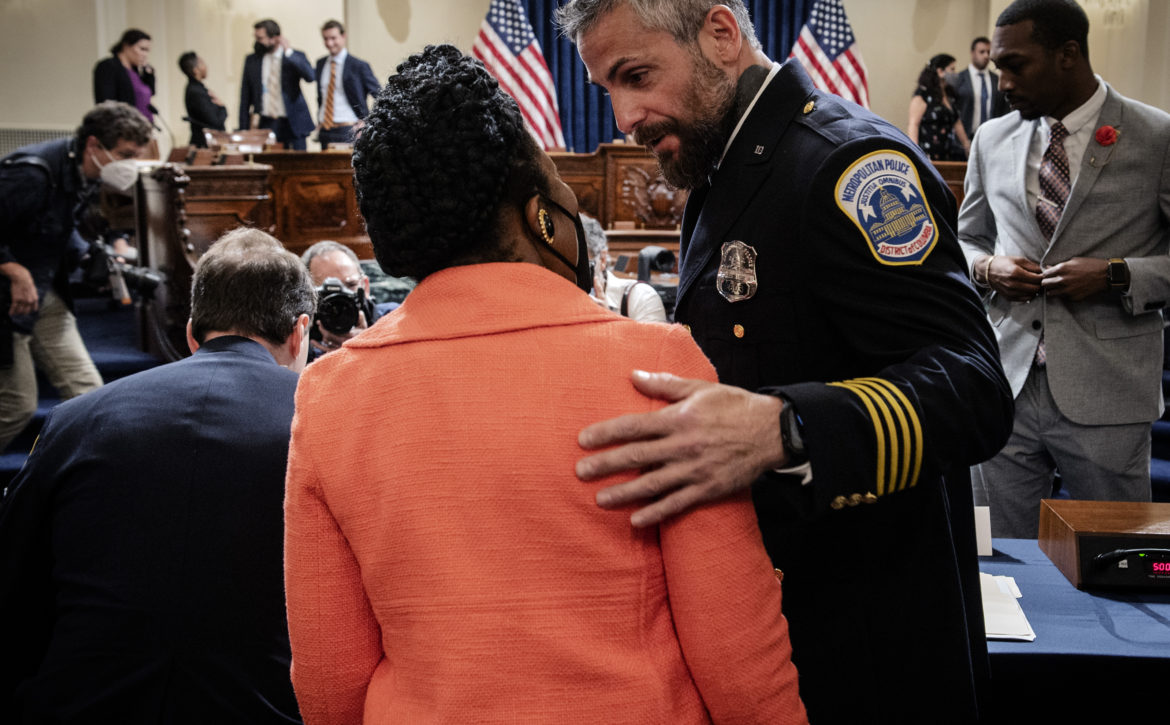
Police Officers Give Congress a Front-Row Seat to the Trauma of Our Politics
Four law enforcement officers who defended the Capitol during the insurrection on January 6 entered a House committee hearing room on Tuesday, cutting striking figures in their uniforms. They provided emotional testimony before the House Select Committee to Investigate January 6, bearing witness to the horrors of that day.While lawmakers huddled in their chambers and later evacuated on January 6, the four officers who offered testimony—two from the Capitol Police Department and two from the Metropolitan Police Department—actually came face-to-face with the rioters who sought to harm members of Congress and overturn the election results. They returned today to a legislative body that remains riven by the destructive politics that led to the uprising in the first place, once again tasked with defending the line—in this case, the one between the raw truth of the events of that day and the murky partisan politics that threatens to occlude it.In such a fractured media environment, it’s unclear whether this hearing and the testimony of the officers will make any difference. According to a poll by CBS News released last week, 55 percent of Trump voters say they would describe what happened at the Capitol as “defending freedom,” and 51 percent said they would describe it as “patriotism.” Republican Representatives Matt Gaetz, Louie Gohmert, Paul Gosar, and Marjorie Taylor Greene—all staunch Trump supporters—planned to hold a press conference on Tuesday “demanding answers on treatment of Jan. 6 prisoners.”The officers provided answers of their own. “For most people, January 6 lasted for a few hours. For those of us who were in the thick of it, it has not ended,” Capitol Police Officer Aquilino Gonell said during his opening statement. An Iraq War veteran, Gonell said that on January 6, he was “more afraid to work at the Capitol than my whole deployment in Iraq.” He likened the day to a “medieval battle” and recalled thinking, “This is how I am going to die.”Metropolitan Police Officer Daniel Hodges described his experience defending the Capitol, saying he was concerned he would “be pulled into the mob and lynched.” He described flags carried by the insurrectionists, including one saying “Jesus is my savior, Trump is my president,” and multiple Thin Blue Line flags, ironically meant to convey support for law enforcement. Hodges, who concisely denounced the rioters who attacked him as “terrorists,” was crushed in a door while he sought to defend an entrance to the Capitol. Capitol Police Officer Harry Dunn heard a rioter say, “President Trump invited us here.” He was later subjected to a “torrent of racial epithets” after he told protesters he voted for Biden.“No one had ever, ever called me a [n-word] while wearing the uniform of a Capitol Police officer,” Dunn said. He added that multiple Black officers told him that they had also been called racial slurs. Hodges, who is white, by contrast recounted how rioters had sought to “recruit” him.Metropolitan Police Officer Michael Fanone suffered a heart attack and a traumatic head injury during the attack, and is struggling with post-traumatic stress. Fanone testified how he was beaten by rioters and electrocuted “again and again and again with a Taser,” while insurrectionists chanted, “Kill him with his own gun.”Fanone, visibly emotional, also expressed anger at the lawmakers who continue to whitewash or downplay the attack: “I feel like I went to hell and back to protect them and the people in this room. But too many are now telling me that hell doesn’t exist, or hell actually wasn’t that bad. The indifference shown to my colleagues is disgraceful.” Fanone punctuated his statement by pounding his hand on the table, encapsulating the unique sense of helplessness and fury that comes from knowing that one of the worst days of your life has been politicized.“What makes the struggle harder and more painful is to know so many of my fellow citizens—including so many of the people I put my life at risk to defend—are downplaying or outright denying what happened,” he said.“There’s no place for politics or partisanship in this investigation. Our only charge is to follow the facts where they lead us,” committee Chair Bennie Thompson said during his opening statement, touting the bipartisan bona fides of the committee, which comprises seven Democrats and two Republicans.But the work of the select committee has been colored by politics throughout its brief existence. The hours and hours of video evidence, more of which is released every day as the Justice Department continues its prosecutions of participants, irrefutably shows the scope and scale of violence. But the attack on January 6 has been a partisan lightning rod from the moment lawmakers reentered a newly cleared Capitol.The select committee was established along partisan lines, with only two Republicans—Representatives Liz Cheney and Adam Kinzinger—voting in favor of its creation. Cheney was ousted from her position as Republican conference chair in May for her frequent criticism of Trump and her refusal to downplay the attack on the Capitol. But her isolation in the party, and the charge from Minority Leader Kevin McCarthy that she and Kinzinger are “Pelosi Republicans,” has only raised her profile.Cheney and Kinzinger are now the only Republicans on the committee, named by Pelosi. McCarthy pulled all of his five appointments after Pelosi rejected two of them, Representatives Jim Jordan and Jim Banks, on the grounds that the pair had voted against certifying President Joe Biden’s electoral victory.The specter of a lengthy select committee investigation—à la Benghazi—in addition to the uneven partisan balance of the committee, was one of the main reasons most House Republicans opted against supporting its creation. Accusations of partisanship will likely only escalate if the committee also subpoenas former Trump officials or the members of Congress, such as McCarthy himself, who reportedly spoke to the former president on January 6.It was perhaps inevitable that the events of January 6 would be highly politicized, given Trump’s iron grip on the party and Republican lawmakers’ fear of alienating his supporters. But in the immediate aftermath of the attack, there were some faint bipartisan calls for an independent commission. Legislation to create such a panel, based closely on the 9/11 Commission, was crafted by Thompson and Republican Representative John Katko. Their bill to create this commission passed the House with the support of 35 Republicans joining all of the Democrats.It wasn’t until the bill reached the Senate, where it required 60 votes to advance, that it foundered. Senate Minority Leader Mitch McConnell argued that it was a “purely political exercise,” redundant amid ongoing congressional investigations. “I do not believe the additional, extraneous commission that Democratic leaders want would uncover crucial new facts or promote healing,” McConnell said at the time.Pelosi waited several weeks to see if Senate Republicans might change their minds before she put the bill creating a select committee on the House floor. Last month, as law enforcement officers who defended the Capitol on January 6 watched from the visitors’ gallery, that bill barely managed to pass the House. Now, like the rest of the country, congressional Republicans must watch the select committee do its work. It has been nearly seven months since lawmakers and Vice President Mike Pence met to certify Joe Biden’s Electoral College victory; nearly seven months since President Trump urged his supporters to march to the Capitol and “fight like hell” to challenge the election results; nearly seven months since thousands of Trump supporters laid siege to the Capitol in a violent attack, resulting in five deaths and more than 140 law enforcement officers injured.More than 100 House Republicans and several Senate Republicans voted to overturn the Electoral College results that day. Trump has continued to deny any culpability for the attack. Many of his fellow Republicans argue that the party needs to move on from January 6; that the committee is but another excuse by Democrats to attack the former president. GOP Representative Andrew Clyde, who helped barricade the House chamber door from rioters, incomprehensibly characterized the insurrection as a “normal tourist visit.” In a press conference on Tuesday morning, Representative Elise Stefanik said that Speaker Nancy Pelosi “bears responsibility” for the attack. It has been a demoralizing seven months for the Capitol Police, as well. Two officers died by suicide in the wake of the attack, and several have left the force. The department is also close to losing funding in August. A security supplemental to provide funding passed in the House but had been stalled in the Senate until today, when Senators finally reached a deal.But despite the challenges in convincing Americans that the insurrection was actually an insurrection, the four police officers all expressed pride for “holding the line” and protecting lawmakers—and democracy—on January 6. Dunn said that “us four officers, we would do January 6 all over again.”“When people say it shouldn’t be political, it was, and it is. There’s no getting around it,” Dunn told the committee, describing Trump as the “hit man” who sent the rioters. “What I ask from you all is to get to the bottom of what happened.”
Read More


